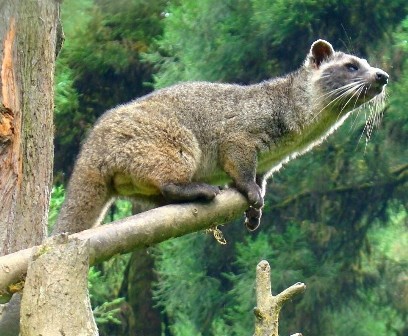
Paguma larvata (Himalayan palm civet)
The Himalayan Palm Civet (Paguma larvata) is a nocturnal and elusive mammal found in the lush forests of the Great Himalayan National Park (GHNP). Though rarely seen, this small carnivore plays an important ecological role in the Himalayan ecosystem.
Physical Description and Identification
The Himalayan palm civet has a long, slender body, grayish-brown fur, a pointed face, and a distinctly bushy tail. It often features a pale face with darker eye patches and a black stripe running from the nose to the top of the head—hence the name “masked civet.”
Habitat and Range in GHNP
In GHNP, the Himalayan palm civet is typically found at lower to mid-elevations, between 1,500 and 3,000 meters, particularly in subtropical broadleaf and temperate forests. It prefers dense vegetation, which provides both shelter and a rich food supply.
Diet and Nocturnal Behavior
An omnivore, the Himalayan palm civet feeds on fruits, berries, small rodents, insects, and birds. Being primarily nocturnal, it spends the daytime resting in tree hollows or dense undergrowth and becomes active at dusk. Its arboreal agility allows it to forage in tree canopies as well as on the ground.
| Common name | Himalayan palm civet. |
| Latin name | Paguma larvata C.E.H.SMITH,1827. |
| Local name | Bichul /Bijju( Garhwali ) |
| IUCN/WPA/Indian status | Least concern/II/ Locally common |
| Social unit | Solitary |
| Size / weight | HBL: 41-76 cm. TL : 50-63 cm. WT : 3.6-5 kg. |
| Description | The Himalayan Palm civet is a dark brown to black large hill civet with greyish buff under parts. It has a thick black un patterned tai and a black chin and throat. The latter characteristic distinguishes it from the yellow throated martin with which it shares a distribution range. Adults do not have spots on their body though flank spots may be present in juvenile. The face has dark mask that is split by a greyish whit line down the fore head white splotches around the eye nose and markings from the ear to the cheek. |
| Behavior | Skunk-like it ejects a foul smelling liquid when disturbed. |
| Distribution | Himalayas from Jammu & Kashmir to Arunachal Pradesh( up to 2500 m) north- eastern hills and the Andaman Islands. |
| Habitat | Evergreen and deciduous montane forests and near human habitation( up to 2500 m). |
| Best seen | Himalayan forests |
Ecological Importance
The civet is a key seed disperser in GHNP, aiding forest regeneration through its frugivorous habits. It also helps control small vertebrate and insect populations, maintaining ecological balance.
Conservation and Threats
Though listed as Least Concern by the IUCN, the Himalayan palm civet faces threats from habitat loss, poaching, and retaliatory killing due to poultry predation in areas near human habitation. GHNP’s protected status offers this species a critical refuge.



